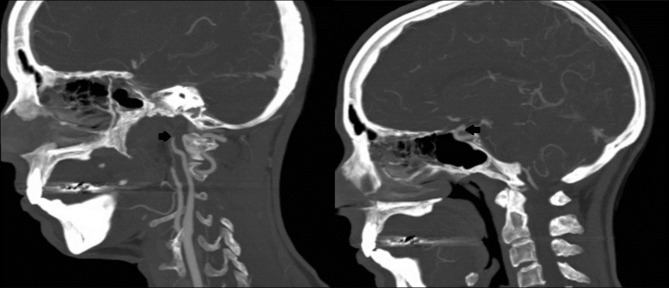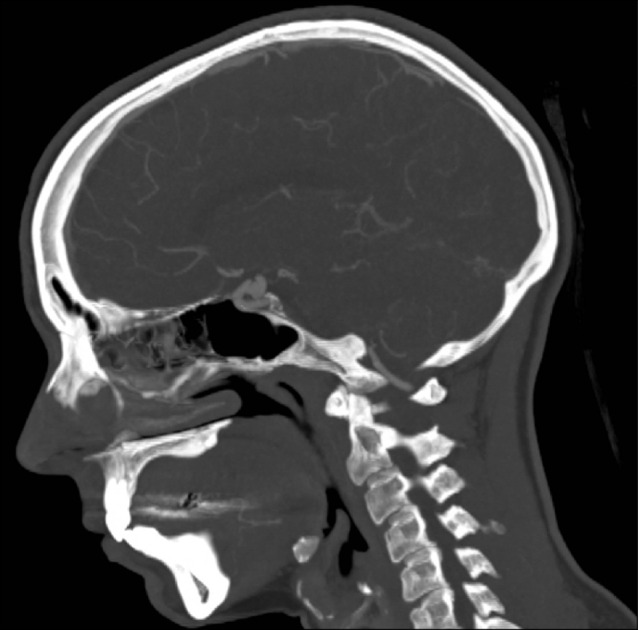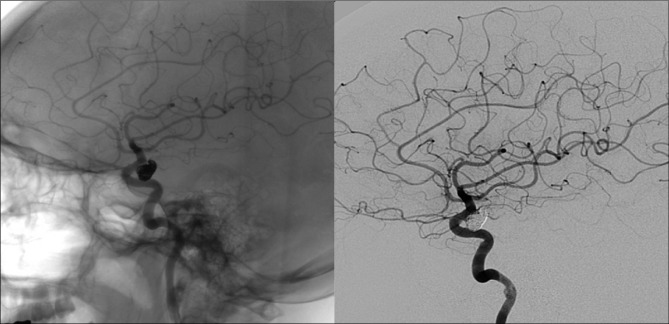J Cerebrovasc Endovasc Neurosurg.
2016 Jun;18(2):110-114. 10.7461/jcen.2016.18.2.110.
Hemodynamic Impact of a Spontaneous Cervical Dissection on an Ipsilateral Saccular Aneurysm
- Affiliations
-
- 1Department of Neurosurgery, Brigham and Women's Hospital and Harvard Medical School, Boston, MA, USA.
- 2Department of Neurosurgery, Barrow Neurological Institute, Phoenix, AZ, USA. Bgross83@gmail.com
- KMID: 2354885
- DOI: http://doi.org/10.7461/jcen.2016.18.2.110
Abstract
- The dynamic, hemodynamic impact of a cervical dissection on an ipsilateral, intracranial saccular aneurysm has not been well illustrated. This 45-year-old female was found to have a small, supraclinoid aneurysm ipsilateral to a spontaneous cervical internal carotid artery dissection. With healing of the dissection, the aneurysm appeared to have significantly enlarged. Retrospective review of the magnetic resonance imaging (MRI) at the time of the initial dissection demonstrated thrombus, similar in overall morphology to the angiographic appearance of the "enlarged" aneurysm. As the dissection healed far proximal to the intradural portion of the internal carotid artery, this suggested that the aneurysm was likely a typical, saccular posterior communicating artery aneurysm that had thrombosed and then recanalized secondary to flow changes from the dissection. The aneurysm was coiled uneventfully, in distinction from more complex treatment approaches such as flow diversion or proximal occlusion to treat an enlarging, dissecting pseudoaneurysm. This case illustrates that flow changes from cervical dissections may result in thrombosis of downstream saccular aneurysms. With healing, these aneurysms may recanalize and be misidentified as enlarging dissecting pseudoaneurysms. Review of an MRI from the time of the dissection facilitated the conclusion that the aneurysm was a saccular posterior communicating artery aneurysm, influencing treatment approach.
Keyword
MeSH Terms
Figure
Reference
-
1. Benninger DH, Georgiadis D, Kremer C, Studer A, Nedeltchev K, Baumgartner RW. Mechanism of ischemic infarct in spontaneous carotid dissection. Stroke. 2004; 2. 35(2):482–485. PMID: 14757894.
Article2. Crutchfield WG. Instruments for use in the treatment of certain intracranial vascular lesions. J Neurosurg. 1959; 7. 16(4):471–474. PMID: 13665405.
Article3. Drake CG, Peerless SJ, Ferguson GG. Hunterian proximal arterial occlusion for giant aneurysms of the carotid circulation. J Neurosurg. 1994; 11. 81(5):656–665. PMID: 7931611.
Article4. Esposito G, Sabatino G, Lofrese G, Albanese A. Carotid artery dissection-related intracranial aneurysm development: case report. Neurosurgery. 2012; 2. 70(2):E511–E514. discussion E514-5. PMID: 21795863.5. Hop JW, Rinkel GJ, Algra A, van Gijn J. Case-fatality rates and functional outcome after subarachnoid hemorrhage: a systematic review. Stroke. 1997; 3. 28(3):660–664. PMID: 9056628.6. Lee VH, Connolly HM, Fulgham JR, Manno EM, Brown RD Jr, Wijdicks EF. Tako-tsubo cardiomyopathy in aneurysmal subarachnoid hemorrhage: an underappreciated ventricular dysfunction. J Neurosurg. 2006; 8. 105(2):264–270. PMID: 17219832.
Article7. Mazighi M, SaintMaurice JP, Rogopoulos A, Houdart E. Extracranial vertebral and carotid dissection occurring in the course of subarachnoid hemorrhage. Neurology. 2005; 11. 65(9):1471–1473. PMID: 16275839.
Article8. Rao AS, Makaroun MS, Marone LK, Cho JS, Rhee R, Chaer RA. Long-term outcomes of internal carotid artery dissection. J Vasc Surg. 2011; 8. 54(2):370–374. discussion 375. PMID: 21620626.
Article9. Rodrigues VJ, Elsayed S, Loeys BL, Dietz HC, Yousem DM. Neuroradiologic manifestations of Loeys-Dietz syndrome type 1. AJNR Am J Neuroradiol. 2009; 9. 30(8):1614–1619. PMID: 19556353.
Article10. Schievink WI, Mokri B, Michels VV, Piepgras DG. Familial association of intracranial aneurysms and cervical artery dissections. Stroke. 1991; 11. 22(11):1426–1430. PMID: 1750052.
Article11. Schievink WI, Mokri B, Whisnant JP. Internal carotid artery dissection in a community. Rochester, Minnesota, 1987-1992. Stroke. 1993; 11. 24(11):1678–1680. PMID: 8236342.
Article12. Sharma GK, Deshmukh VR, Albuquerque FC, Wolf TR, McDougall CG. Resolution of mydriatic pupil after angioplasty and stenting of cervical internal carotid artery dissection: case report. Neurosurgery. 2009; 3. 64(3):E562–E563. discussion E563. PMID: 19240581.13. Surdell DL, Hage ZA, Eddleman CS, Gupta DK, Bendok BR, Batjer HH. Revascularization for complex intracranial aneurysms. Neurosurg Focus. 2008; 2. 24(2):E21.
Article
- Full Text Links
- Actions
-
Cited
- CITED
-
- Close
- Share
- Similar articles
-
- Thrombosis and Recanalization of Small Saccular Cerebral Aneurysm : Two Case Reports and a Suggestion for Possible Mechanism
- Spontaneous Resolution of Dissecting Aneurysm of the Vertebral Artery
- Saccular Aneurysm of Intraheparic Portal Vein Mimicking Hypervascular Hepatic Mass: A Case Report
- Spontaneous Disappearance and Recanalization of Ruptured Pericallosal Artery Aneurysm
- Endovascular Stent Graft for Treatment of Complicated Spontaneous Dissection of Celiac Artery: Report of Two Cases






